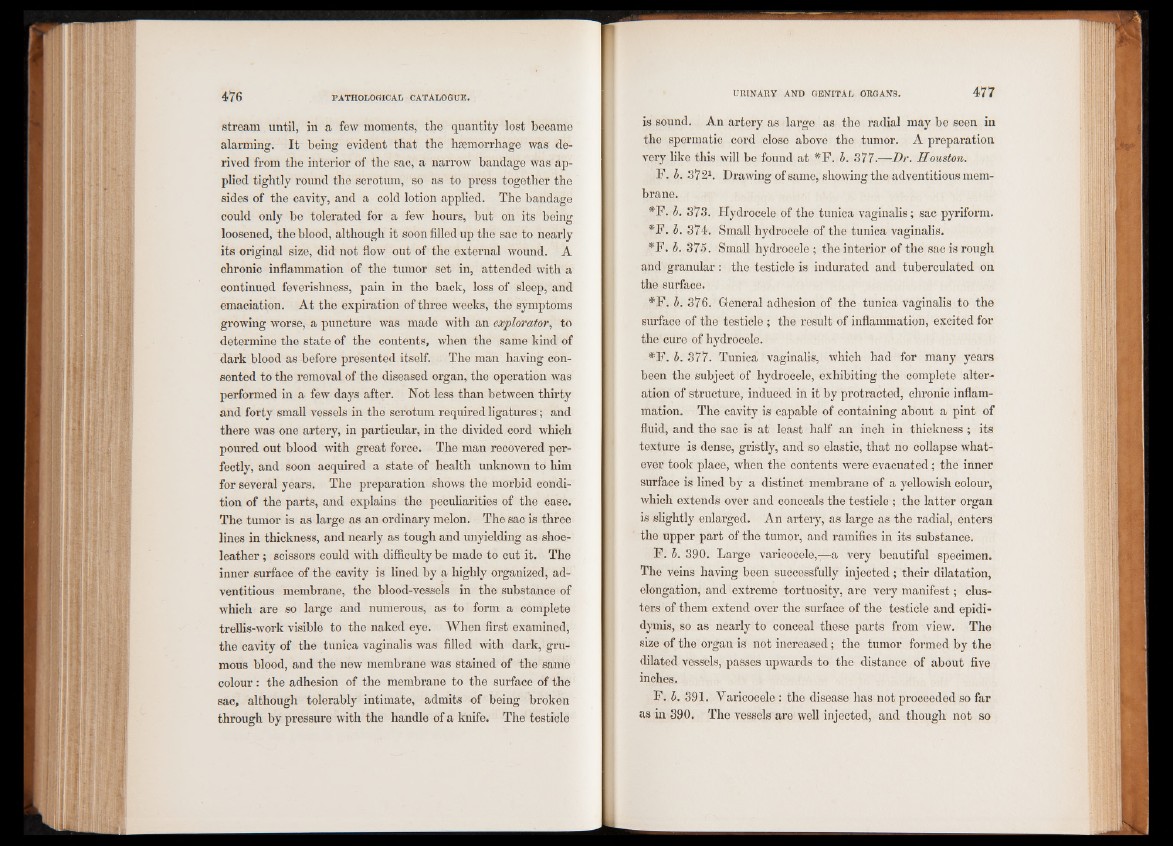
stream until, in a few moments, the quantity lost became
alarming. It being evident that the haemorrhage was derived
from the interior of the sac, a narrow bandage was applied
tightly round the scrotum, so as to press together the
sides of the cavity, and a cold lotion applied. The bandage
could only be tolerated for a few hours, but on its being
loosened, the blood, although it soon filled up the sac to nearly
its original size, did not flow out of the external wound. A
chronic inflammation of the tumor set in, attended with a
continued feverishness, pain in the back, loss of sleep, and
emaciation. At the expiration of three weeks, the symptoms
growing worse, a puncture was made with an exploratory to
determine the state of the contents, when the same kind of
dark blood as before presented itself. The man having consented
to the removal of the diseased organ, the operation was
performed in a few days after. Not less than between thirty
and forty small vessels in the scrotum required ligatures; and
there was one artery, in particular, in the divided cord which
poured out blood with great force. The man recovered perfectly,
and soon acquired a state of health unknown to him
for several years. The preparation shows the morbid condition
of the parts, and explains the peculiarities of the case.
The tumor is as large as an ordinary melon. The sac is three
lines in thickness, and nearly as tough and unyielding as shoe-
leather ; scissors could with difficulty be made to cut it. The
inner surface of the cavity is lined by a highly organized, adventitious
membrane, the blood-vessels in the substance of
which are so large and numerous, as to form a complete
trellis-work visible to the naked eye. When first examined,
the cavity of the tunica vaginalis was filled with dark, gru-
mous blood, and the new membrane was stained of the same
colour: the adhesion of the membrane to the surface of the
sac, although tolerably intimate, admits of being broken
through by pressure with the handle of a knife. The testicle
is sound. An artery as large as the radial may be seen in
the spermatic cord close above the tumor. A preparation
very like this will be found at #F. b. 377.—Dr. Houston.
F. b. 3721. Drawing of same, showing the adventitious membrane.
*F. b. 373. Hydrocele of the tunica vaginalis; sac pyriform.
*F. b. 374. Small hydrocele of the tunica vaginalis.
*F. b. 375. Small hydrocele ; the interior of the sac is rough
and granular: the testicle is indurated and tuberculated on
the surface.
#F. b. 376. General adhesion of the tunica vaginalis to the
surface of the testicle ; the result of inflammation, excited for
the cure of hydrocele.
#F. b. 377. Tunica vaginalis, which had for many years
been the subject of hydrocele, exhibiting the complete alteration
of structure, induced in it by protracted, chronic inflammation.
The cavity is capable of containing about a pint of
fluid, and the sac is at least half an inch in thickness ; its
texture is dense, gristly, and so elastic, that no collapse whatever
took place, when the contents were evacuated; the inner
surface is lined by a distinct membrane of a yellowish colour,
which extends over and conceals the testicle ; the latter organ
is slightly enlarged. An artery, as large as the radial, enters
the upper part of the, tumor, and ramifies in its substance.
F. b. 390. Large varicocele,—a very beautiful specimen.
The veins having been successfully injected ; their dilatation,
elongation, and extreme tortuosity, are very manifest; clusters
of them extend over the surface of the testicle and epididymis,
so as nearly to conceal these parts from view. The
size of the organ is not increased; the tumor formed by the
dilated vessels, passes upwards to the distance of about five
inches.
F. b. 391. Varicocele ; the disease has not proceeded so far
as in 390. The vessels are well injected, and though not so